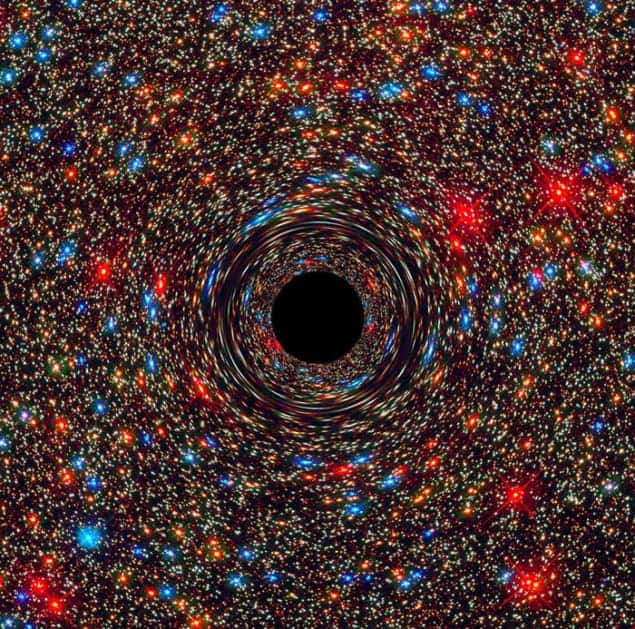
For 40 years, physicists have struggled to resolve a problem put forward by astrophysicist Stephen Hawking: that black holes appear to destroy all of the information that passes their event horizons. This destruction creates a “black-hole information paradox” because it contradicts determinism, one of the most fundamental principles of science. Now, Hawking and two colleagues think they may have found a way around the problem, at least in part, thanks to information-preserving massless particles known as “soft hair”, which they say should surround black holes.
The information paradox emerged in the 1970s after Hawking used quantum mechanics to describe events at the edge of a black hole. General relativity predicts that black holes form whenever massive objects such as a large star collapse in on themselves and create a gravitational field so strong that space–time is bent into a closed loop. This creates a shell of no return, known as an event horizon, beyond which any object and any light ray is completely cut off from the rest of the universe.
Quantum mechanics dictates that pairs of virtual particles can pop into and out of existence within the vacuum, and Hawking considered what would happen to such virtual particles near to an event horizon. He reasoned that one particle from each pair would be swallowed up by the black hole, while the other would be emitted to create what we now call “Hawking radiation”. Because that radiation would remove energy from the black hole, it would cause the black hole to evaporate and eventually disappear – in the absence of any other nearby sources of matter.
Lost information
Hawking realized the potentially devastating effect of this process on information. He concluded that because the emitted radiation is generated at the edge of a black hole, it could tell us no more than an external observer can learn – namely, the values of a black-hole’s mass, charge and angular momentum. All other information – in other words, how much of each of the three quantities was possessed by the individual objects sucked into the black hole – would be lost forever.
Hawking’s colleague Andrew Strominger of Harvard University explains that quantum mechanics, like classical physics, tells us that the universe evolves deterministically; it is just that what is determined is not the values of the position and momentum of individual particles, but rather the wavefunction of the universe as a whole – measuring devices included. “People find it very hard to accept that in the quantum world, momentum and position are not absolute quantities,” he says. “But that pales into insignificance compared with what we would have to accept were Hawking’s contention true. We would have to accept that there are no laws of physics.”
Now, Strominger, Hawking and Cambridge’s Malcolm Perry have put forth a solution to the black-hole information paradox – with due caution. Two years ago, Strominger showed that general relativity predicts an infinite number of symmetries, and therefore an infinite number of conservation laws, in nature. This, he explains, invalidates one of two assumptions underlying Hawking’s paradox; namely, that a vacuum only has one quantum state per energy level. The existence of a “degenerate” vacuum, he says, is mathematically equivalent to an infinite number of possible symmetries, and implies that information can live on – encoded in the different vacuum states – once a black hole has evaporated away.
More information than was previously thought possible can escape from black holes
Andrew Strominger, Harvard University
The other assumption overturned by the new research is that black holes have no “hair” – a term coined by John Wheeler to refer to any information about a black-hole’s make-up besides its total mass, charge and angular momentum. Hawking, Perry and Strominger show that some of the information contained within electric charges crossing an event horizon in fact remains in the form of zero-energy or “soft” photons distributed around the horizon, which they dub “soft hair”. Strominger explains that black holes with “different hairdos” emit Hawking radiation with different spectra, and that, as such, “more information than was previously thought possible can escape from black holes.”
The finding has received a cautious welcome from other physicists. Dejan Stojkovic at the University at Buffalo in the US believes the idea to be “worth pursuing”, but points out that it can only account for a part of the information that enters a black hole. In particular, he notes that because vacuum states are distinguished by angular momentum, two different black holes having the same mass and angular momentum – caused by the collapse of a single spherically symmetrical shell as opposed to two concentric shells, for example – will appear indistinguishable.
Firewall problem
Sabine Hossenfelder of the Frankfurt Institute for Advanced Studies in Germany says that the new work should also help to solve what is known as the firewall problem, which posits a conflict between information-rich Hawking radiation and general relativity’s equivalence principle. But she agrees that the proposed model is rather limited as it stands, pointing out that it deals with electromagnetic but not gravitational interactions. She also says that the authors fail to spell out exactly how the information in the hair becomes encoded into the Hawking radiation.
In their paper, Strominger, Perry and Hawking acknowledge the limitations of their work and do not claim that they have fully resolved the information paradox. “We are just putting one foot in front of another and seeing where that leads us,” says Strominger. “But it is exciting that for the first time in many decades a fundamental flaw seems to have been discovered in the original argument.”
The work is described in Physical Review Letters.



